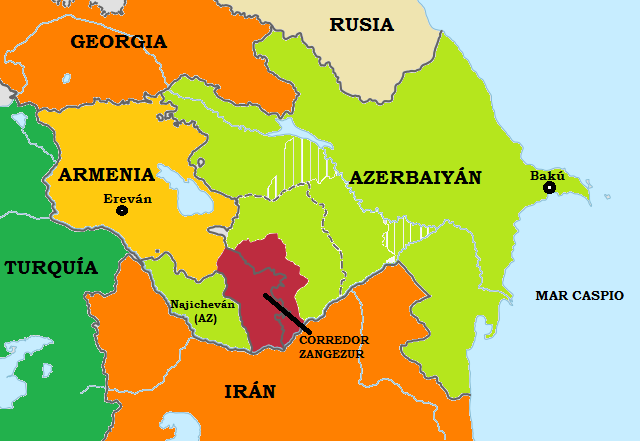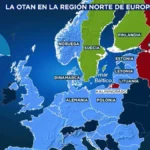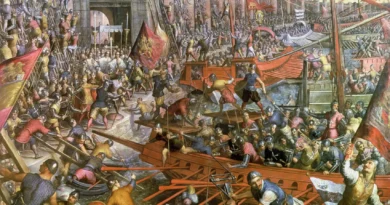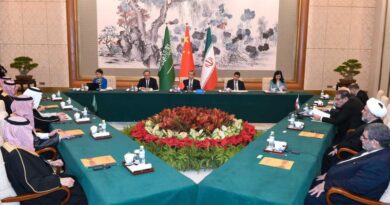The Zangezur corridor, the key piece of relations between Armenia and Azerbaijan
The Governments of the Republics of Armenia and Azerbaijan announced last Friday that, for the first time since the implosion of the Union of Soviet Socialist Republics (USSR), they had reached an agreement to establish the border delimitation between their two countries.
The new interstate boundary will run between the villages of Baghanis, Baghanis-Ayrum, Voskepar, Asagi Eskipara, Kirants, Heyrimli, Berkaber and Kizilhacili, in the northern areas of Armenia and Azerbaijan located near Georgia.
The Armenian Prime Minister, Nikol Pashinian, declared to the state news agency Armpress that, through this agreement, "the Republic of Armenia achieves a reduction in risks related to security and border delimitation" and that the pact "can be described as an important development."
But he did not say whether his Cabinet negotiators and those of Azerbaijani President Ilham Aliyev have discussed the ever-pending issue of the union of the eastern territories of Azerbaijan with the Autonomous Republic of Nakhchivan, whose Azeri sovereignty is recognized by the international community.
Zangezur, an obstacle
The best way to realize this connection is through the Zangezur corridor, which is located in the southernmost part of the Armenian province of Siunyk. And the most important reason why Baku wants to do it is to have safe and permanent access to the border that Nakhchivan shares with Turkey, its ally in the territorial conflicts it has had with Armenia since the 1990s.
The end of the republic's isolation can facilitate the establishment of a very lucrative business between Ankara and the Azeris. Two years ago, the president of the European Commission, Ursula von der Leyen, and Aliyev signed an agreement that made Azerbaijan one of the main suppliers of natural gas to the European Union (EU).
The Caucasian country has some reserves of 2,6 million cubic meters of gas, and his Government is willing to double the amount it already sends to Europe within a maximum period of three years. The only problem is that to do so, it has to control the Zangezur corridor, since almost all of the oil and gas pipelines that previously transported the Caspian Sea's abundant natural resources to European homes pass through Russian territory.
As the EU, in accordance with the US Administration of Joe Biden, has imposed economic sanctions on the Russian Executive for invading Ukraine in February 2022, Moscow has blocked the pipelines through which gas and oil transited to the treatment and processing plants. distribution of the 27 member states.
The hydrocarbon network
The only Azerbaijani pipeline that continues to carry Caspian hydrocarbons to Europe is the that runs through Georgia and Türkiye. From there, it flows into the West. The large detour that runs through northern Armenia causes delays and a considerable increase in prices.
There are only two alternative routes to Baku. The first is to transfer the gas to Turkey through northern Iran, although it is unfeasible. Tehran is one of Russia's closest partners in the region and has always distrusted Azerbaijan and its relations with the Azeri-Iranian minority, which it sees as a pan-Turkic fifth column within its own population.
The second is based on the appropriation of the Zangezur corridor by Azerbaijan. But the seizure of the Armenian exclave of the Republic of Artsakh in Nagorno-Karabakh by Azeri troops last September has changed the situation, since Yerevan has publicly confirmed its commitment to the principles of respect for sovereignty dictated in the Alma Ata Declaration of 1991.
Exchanges
The Caucasus is undergoing a profound geopolitical reordering. Armenia, a traditional ally of Russia in the area, has been distancing itself from Moscow since 2018, when Pashinian came to power.
Its definitive approach to the West occurred after Aliyev's victory in Karabakh. As a result, Moscow will be forced to reorient its foreign policy in the area.
One option could be to create an alliance with Azerbaijan through Türkiye. The Russian president, Vladimir Putin, maintains very good relations with his leader, Recep Tayip Erdogan, because he helped him avoid EU sanctions and even offered to mediate between him and the top Ukrainian leader, Volodymyr Zelensky, to put an end to to the war in Europe.
In fact, the execution of a diplomatic campaign to deepen relations with these states could lead to the formation of a Eurasian "multipolar" oligopoly in the hydrocarbon sector and stop, or at least alleviate the effects, of the projection of the US and the EU on Armenia.
However, the unknown to be resolved in this possible equation would be Iran, which also distrusts Turkey because it has had important differences with it in regional crises such as the Syrian civil war. Given the close Russian-Iranian cooperation in the Middle East, the essential question is: to what extent could Moscow push to include its ally in the new partnership?
Jayro sanchez is a Spanish journalist.












